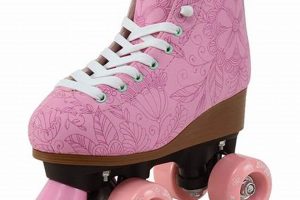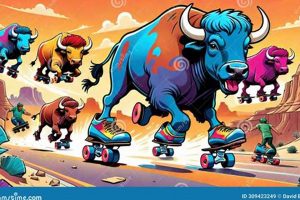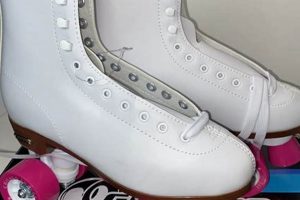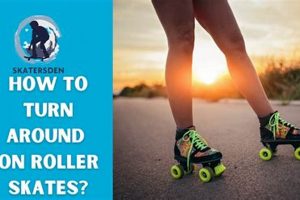Footwear consisting of four wheels arranged in a two-by-two configuration, designed for recreational or competitive skating, and manufactured to accommodate the anatomical structure of adult males. These items feature a supportive boot, typically made of leather or synthetic materials, attached to a chassis that holds the wheels, bearings, and toe stop. One example is a model specifically built for artistic roller skating, emphasizing maneuverability and ankle support.
Such equipment provides a unique combination of stability and agility, making it suitable for various activities, including rink skating, outdoor cruising, and roller derby. Their origins can be traced back to the 19th century, evolving significantly in design and materials to meet the demands of modern skaters. The arrangement of the wheels offers enhanced balance, particularly beneficial for beginners and those seeking a stable platform for executing complex maneuvers.
A detailed examination of the different styles available, considerations for choosing the correct size and fit, and guidance on maintenance and safety precautions will be presented in subsequent sections. These considerations are crucial for maximizing the user’s experience and ensuring both performance and longevity of the equipment.
Essential Considerations
The following recommendations are designed to optimize the experience and ensure the longevity of the equipment.
Tip 1: Size Accuracy. Accurate foot measurement is paramount. Consult size charts specific to the manufacturer, as sizing varies considerably. Opt for a snug fit that allows for minimal internal movement.
Tip 2: Boot Material Assessment. Leather provides superior support and molds to the foot over time. Synthetic materials offer lighter weight and increased water resistance. Evaluate the skating environment and intended use to determine the optimal material.
Tip 3: Chassis and Plate Selection. Aluminum chassis offer increased durability and responsiveness compared to nylon. Consider a higher-end chassis for demanding applications such as roller derby or aggressive skating.
Tip 4: Wheel Durometer Evaluation. Wheel hardness, measured in durometer, influences grip and roll speed. Softer wheels (lower durometer) provide greater grip; harder wheels (higher durometer) offer faster speeds. Select a durometer appropriate for the skating surface.
Tip 5: Bearing Maintenance. Regular cleaning and lubrication of bearings ensure smooth rolling and extend their lifespan. Remove bearings periodically and clean with a solvent designed for bearing maintenance.
Tip 6: Toe Stop Adjustment. Adjust the toe stop height to optimize braking and maneuverability. Ensure the toe stop is securely tightened before each use. Replace the toe stop when significant wear is observed.
Tip 7: Protective Gear Implementation. Helmets, wrist guards, elbow pads, and knee pads are essential for injury prevention. Select protective gear that fits properly and meets recognized safety standards.
Adherence to these considerations will enhance comfort, performance, and safety, maximizing the utility of the chosen equipment.
The concluding section will summarize key aspects discussed and provide resources for further exploration.
1. Stability
Stability, in the context of footwear designed for adult males using a four-wheeled configuration, is a foundational attribute impacting both safety and performance. The wheel arrangement inherently provides a wider base of support compared to inline designs, thereby reducing the likelihood of lateral instability and falls. This is particularly relevant for novice skaters or individuals requiring enhanced balance due to physical limitations or specific skating disciplines. The inherent stability is a primary reason why these implements are often recommended for beginners learning fundamental skating techniques.
The degree of stability can be further influenced by several design parameters. A lower center of gravity, achieved through a lower boot profile and chassis design, enhances stability by minimizing the leverage exerted on the skater’s ankles. Wider wheelbases, the distance between the front and rear axles, also contribute to improved stability, albeit at the potential cost of reduced maneuverability. For example, skates designed for recreational use commonly prioritize stability with a wider wheelbase and lower boot to facilitate easy balance and control during leisurely skating sessions. In contrast, skates tailored for more advanced styles prioritize other aspects and may reduce stability by using taller boots for ankle support.
Understanding the relationship between stability and implement design is crucial for selecting the appropriate equipment. Prioritizing stability mitigates risk and fosters a positive learning curve. While experienced skaters may prefer designs that trade stability for maneuverability, those prioritizing safety or learning the fundamentals benefit directly from designs that maximize stability. Recognizing the impact of wheel base, boot profile, and chassis design contributes to a more informed user experience, ultimately resulting in greater enjoyment and reduced risk of injury.
2. Durability
Durability is a critical attribute of footwear designed for adult males employing a four-wheeled configuration, directly impacting longevity, performance consistency, and overall value. The ability to withstand repeated stress and resist degradation from environmental factors determines the lifespan and sustained functionality of the product. Understanding the factors influencing durability facilitates informed purchasing decisions and appropriate maintenance practices.
- Chassis Material and Construction
The chassis, or plate, forms the structural foundation and bears the brunt of impact forces. Materials such as aluminum alloys offer superior strength and resistance to bending or cracking compared to nylon or plastic. The construction method, whether cast or forged, also impacts durability. Forged aluminum chassis exhibit greater density and resistance to fatigue, making them suitable for demanding applications such as roller derby or aggressive skating.
- Boot Material Composition and Stitching
The boot’s material composition significantly affects its resistance to abrasion, tearing, and environmental degradation. Leather boots, while offering superior comfort and moldability, require proper maintenance to prevent cracking or drying. Synthetic materials, such as reinforced nylon or polyurethane, provide increased water resistance and durability at a potentially lower cost. Stitching quality and thread type further contribute to boot integrity. Reinforced stitching in high-stress areas prevents seam failure and prolongs the boot’s lifespan.
- Wheel Durometer and Bearing Quality
Wheel durometer, a measure of hardness, influences wear resistance. Harder wheels (higher durometer) exhibit greater durability on abrasive surfaces such as asphalt or concrete, but may offer less grip compared to softer wheels. Bearing quality affects rolling efficiency and longevity. Sealed bearings offer greater protection against dirt and moisture, extending their lifespan and maintaining consistent performance. High-precision bearings, constructed from hardened steel, exhibit superior wear resistance and reduced friction.
- Toe Stop Material and Attachment
The toe stop, used for braking and certain maneuvers, experiences significant wear. Materials such as natural rubber or polyurethane offer varying degrees of abrasion resistance and grip. The method of attachment, whether threaded or bolted, influences its security and resistance to loosening or detachment under stress. Regular inspection and replacement of worn toe stops are essential for maintaining safety and control.
The interplay of these factors collectively determines the product’s lifespan and performance consistency. Selecting models with durable chassis, robust boot construction, appropriate wheel durometer, high-quality bearings, and replaceable toe stops ensures a longer service life and sustained performance across diverse skating environments. Consistent maintenance practices, including cleaning, lubrication, and timely replacement of worn components, further enhance the overall durability and value proposition of the equipment.
3. Maneuverability
Maneuverability, within the context of quad roller skates for men, represents the capacity to execute controlled changes in direction and speed. It is a performance characteristic dictated by design elements and skater skill, crucial for diverse skating styles ranging from recreational cruising to competitive disciplines. Maximized maneuverability enables efficient navigation of varied terrains, execution of intricate maneuvers, and agile responsiveness to dynamic environments.
- Wheelbase Length
The wheelbase, defined as the distance between the front and rear axles, inversely affects maneuverability. Shorter wheelbases permit tighter turning radii and increased agility, facilitating rapid directional changes. Conversely, longer wheelbases enhance stability at the expense of agility. Skates designed for artistic skating or roller derby typically feature shorter wheelbases to optimize maneuverability, whereas recreational models prioritize stability with extended wheelbases. For instance, a shorter wheelbase enables quicker pivots during roller derby matches, while a longer wheelbase provides enhanced stability for recreational skaters learning basic techniques.
- Wheel Durometer and Profile
Wheel durometer, measuring hardness, and wheel profile, describing the wheel’s cross-sectional shape, jointly influence maneuverability. Softer wheels (lower durometer) offer greater grip and facilitate smoother turns on slick surfaces, while harder wheels (higher durometer) reduce rolling resistance and enable faster speeds on smooth surfaces but may compromise grip during sharp turns. Round wheel profiles promote smoother transitions between edges, enhancing maneuverability during carving maneuvers. In contrast, flatter wheel profiles provide increased stability and grip during straight-line skating. The selection of appropriate wheel durometer and profile depends on the intended skating environment and desired balance between speed, grip, and agility.
- Truck Adjustment and Kingpin Angle
Trucks, the pivoting mechanisms connecting the wheels to the chassis, and kingpin angle, the angle of the kingpin relative to the chassis, collectively govern turning responsiveness. Looser truck settings permit greater lean and tighter turns, increasing maneuverability. Conversely, tighter truck settings enhance stability but reduce turning responsiveness. Kingpin angle influences the sensitivity of the trucks to weight shifts. Steeper kingpin angles provide quicker turning responses, while shallower angles offer greater stability. The adjustment of truck settings and kingpin angle enables customization of turning characteristics to suit individual skating styles and preferences.
- Boot Height and Stiffness
Boot height, the vertical extension of the boot above the ankle, and boot stiffness, the resistance to flexion, influence ankle support and control, indirectly impacting maneuverability. Taller boots provide greater ankle support, enabling more aggressive lean angles and sharper turns. Stiffer boots offer increased responsiveness and control during demanding maneuvers but may restrict ankle mobility. Lower boots offer greater freedom of movement and enhance agility but may compromise ankle support during high-impact activities. The selection of appropriate boot height and stiffness depends on the skater’s skill level, skating style, and tolerance for ankle restriction.
These factors are essential considerations in the selection of quad roller skates. The trade-offs between maneuverability and stability must be weighed against the intended use of the equipment. By understanding these characteristics, an informed decision that aligns with individual needs and skating style can be reached.
4. Comfort
Ergonomic design and fit are paramount to the enjoyment and performance associated with quad roller skates intended for male users. Discomfort can lead to premature fatigue, reduced control, and potential injury. Therefore, the selection of skates prioritizing ergonomic considerations is of considerable importance.
- Boot Material and Padding
The composition of the boot material and the integration of internal padding directly influence comfort levels. Leather boots offer breathability and conform to the foot’s contours over time, providing a customized fit. Synthetic materials, such as padded nylon, may offer lighter weight but potentially compromise breathability. Padding strategically placed around the ankle, tongue, and heel counter mitigates pressure points and reduces friction, enhancing overall comfort during extended use. Insufficient padding leads to blisters and discomfort, hindering performance and user satisfaction. Real-world examples include recreational skaters prioritizing plush padding for leisurely sessions, while competitive skaters may accept reduced padding for enhanced responsiveness.
- Footbed and Arch Support
The footbed provides cushioning and support to the plantar surface of the foot, mitigating impact forces and promoting proper alignment. Contoured footbeds with integrated arch support distribute pressure evenly, reducing strain on the arches and preventing foot fatigue. Flat footbeds offer minimal support and can exacerbate discomfort for individuals with high or low arches. Aftermarket footbeds, designed to address specific foot conditions, enable customization and enhance comfort levels. Examples include orthotic inserts for individuals with plantar fasciitis and cushioned footbeds for skaters seeking impact absorption. The incorporation of appropriate arch support is critical for long-term comfort and injury prevention.
- Ventilation and Moisture Management
Adequate ventilation is essential for regulating temperature and preventing moisture buildup inside the boot. Perforated materials and strategically placed vents promote airflow, dissipating heat and reducing perspiration. Excessive moisture leads to discomfort, blistering, and bacterial growth. Moisture-wicking liners draw sweat away from the skin, maintaining a dry and comfortable environment. Examples include skates designed for outdoor skating incorporating breathable mesh panels and skates designed for indoor use featuring moisture-wicking linings. Effective ventilation and moisture management are critical for maintaining comfort during prolonged skating sessions.
- Closure System and Fit Adjustability
The closure system, encompassing laces, straps, and buckles, secures the foot within the boot and allows for fit adjustments. Laces provide a customized fit and allow for independent adjustment of tension across different areas of the foot. Straps and buckles offer quick and easy adjustment, providing a secure and supportive fit. Inadequate closure systems result in slippage and instability, compromising comfort and control. Skates featuring micro-adjustable buckles or ratcheting closures enable precise fit adjustments, accommodating variations in foot size and shape. Secure and adjustable closure systems are crucial for maximizing comfort and performance.
The aforementioned factors highlight the interconnectedness of design and comfort within products for this activity. The selection of appropriate materials, incorporation of supportive features, and implementation of effective closure systems contribute to a more comfortable and enjoyable skating experience. Consideration of these elements will support increased usage and promote user satisfaction for adult male skaters.
5. Adjustability
Adjustability is a crucial design attribute in footwear incorporating four wheels for adult males, directly impacting comfort, performance, and overall utility. This attribute refers to the capacity to modify specific components of the skates to accommodate individual anatomical variations, skating styles, and environmental conditions. The absence of adequate adjustability results in compromised fit, reduced control, and increased risk of injury. A direct consequence of properly implemented adjustability is enhanced user satisfaction and expanded applicability across diverse skating contexts.
Examples of adjustability manifest in several key areas. Truck tightness, influencing turning responsiveness, is typically adjustable via a nut on the kingpin. This allows skaters to fine-tune steering sensitivity according to preference. Toe stop height, critical for braking and balance, is another common adjustment point, catering to individual stride length and reaction time. Boot closure systems, often incorporating laces, straps, and buckles, provide variable tension across different foot regions, accommodating varying foot volumes and preventing slippage. Ankle strap position, available on certain models, can influence the degree of ankle support, addressing stability concerns. Furthermore, some high-end models permit adjustable wheel alignment, optimizing roll efficiency and handling characteristics. Each of these adjustments directly modifies the skater’s interface with the equipment, influencing control, comfort, and performance.
Therefore, the significance of adjustability in four-wheeled footwear for adult males lies in its capacity to personalize the skating experience, maximizing both comfort and control. Ignoring adjustability constraints performance, increases injury risk, and diminishes long-term user satisfaction. A comprehensive understanding of adjustability options empowers users to select skates that best suit their individual needs and to fine-tune those skates for optimal performance across varied skating environments. While advanced adjustment options may increase cost, the resultant improvements in comfort, control, and longevity often justify the investment.
6. Wheel Type
The selection of the appropriate wheel type significantly impacts the performance and suitability of quad roller skates for men. Different wheel characteristics cater to specific skating styles, surfaces, and user preferences, influencing speed, grip, and overall maneuverability. A thorough understanding of wheel types is essential for optimizing the skating experience.
- Durometer (Hardness)
Durometer, measured on the A scale, quantifies wheel hardness. Lower durometer values indicate softer wheels, offering increased grip and shock absorption, making them suitable for rough surfaces or indoor rinks. Higher durometer values denote harder wheels, providing greater speed and durability on smooth surfaces like polished concrete or hardwood floors. For instance, a roller derby skater might prefer a higher durometer wheel for speed and agility, while a recreational skater on asphalt might opt for a softer wheel for better grip. Wheel choice directly impacts skater comfort and performance, depending on the terrain.
- Wheel Diameter
Wheel diameter influences both speed and acceleration. Larger diameter wheels generally provide faster top speeds due to greater rolling circumference but require more effort to accelerate. Smaller diameter wheels offer quicker acceleration and enhanced maneuverability, suitable for tight turns and quick stops. Artistic skaters often favor smaller diameter wheels for intricate footwork, while speed skaters prioritize larger diameter wheels for maximizing velocity. The selection depends on the desired balance between speed and agility.
- Wheel Material
Wheel material affects grip, durability, and vibration dampening. Polyurethane is a common material offering a balance of these properties. Different polyurethane formulations exist, each with varying levels of rebound and wear resistance. Natural rubber wheels provide exceptional grip but tend to wear more quickly. Hybrid wheels combine different materials to optimize specific performance characteristics. For example, some wheels use a harder outer layer for durability and a softer inner core for grip. The selected material directly impacts the longevity and performance of the wheels.
- Wheel Profile (Shape)
Wheel profile describes the cross-sectional shape of the wheel. Rounded profiles promote smoother transitions between edges, enhancing maneuverability for carving and turning. Flatter profiles offer greater contact area with the skating surface, increasing stability and grip for straight-line skating. Beveled edges reduce friction during slides and facilitate controlled stops. The wheel profile should align with the intended skating style and desired balance between agility and stability. A skater performing artistic routines will prefer a rounded profile for fluid movements.
Ultimately, the optimal wheel type for quad roller skates depends on individual skating preferences, skill level, and intended use. Careful consideration of durometer, diameter, material, and profile allows for informed selection, maximizing performance and ensuring a comfortable and enjoyable skating experience for men engaging in this activity. Adapting wheel choice to terrain is paramount to the skating experience.
7. Boot Support
Adequate boot support is a critical factor influencing performance, safety, and comfort in quad roller skates designed for the male anatomy. The boot serves as the primary interface between the skater and the equipment, directly transmitting forces and controlling movement. Insufficient support compromises stability, increases the risk of ankle injury, and reduces skating efficiency.
- Ankle Stability
The primary function of boot support is to stabilize the ankle joint, preventing excessive pronation, supination, and lateral movement. High-cut boots extending above the ankle provide greater stability, particularly beneficial for beginners or individuals with pre-existing ankle weaknesses. Stiffer boot materials, such as reinforced leather or synthetic composites, further enhance ankle support. Roller derby skaters, who frequently engage in aggressive maneuvers and rapid directional changes, require robust ankle support to minimize the risk of sprains or fractures. Without sufficient support, ankle instability results in reduced control and potential injury.
- Force Transmission
The boot facilitates efficient force transmission from the skater’s leg muscles to the wheels, enabling propulsion and control. A supportive boot minimizes energy loss due to flexing or deformation, maximizing skating efficiency. Stiff boot soles and reinforced heel counters enhance force transmission, allowing skaters to generate greater power and maintain precise control during complex maneuvers. Artistic skaters rely on supportive boots to execute intricate footwork and jumps with precision. Inadequate force transmission leads to fatigue and reduced skating performance.
- Protection and Impact Absorption
The boot provides protection against impacts and abrasions, shielding the foot and ankle from injury. Padded linings and reinforced toe boxes absorb shock and protect against collisions with obstacles or other skaters. High-quality boots incorporate impact-resistant materials in critical areas, such as the ankle and heel, to mitigate the risk of fractures or contusions. Aggressive skaters, who frequently perform grinds and slides, require durable and protective boots to withstand the rigors of their sport. The protective function is an essential attribute of boot design.
- Comfort and Fit
While prioritizing support, boots must also provide adequate comfort and a secure fit to prevent blisters and chafing. Ergonomically designed boots with anatomical contours conform to the shape of the foot, minimizing pressure points and maximizing comfort. Padded linings and breathable materials enhance ventilation and reduce moisture buildup, maintaining a comfortable skating environment. Proper fit is essential for preventing slippage and ensuring optimal control. Ill-fitting boots result in discomfort, reduced performance, and increased risk of injury. The balance of support and comfort is key to a positive skating experience.
Boot support is a multifactorial attribute encompassing ankle stability, force transmission, protection, and comfort. The selection of skates with appropriate boot support is paramount for ensuring safe, efficient, and enjoyable skating experiences for men. The specific level of support required depends on the skater’s skill level, skating style, and individual anatomical considerations. Evaluating support based on each facet provides better skating experience for quad roller skates for men.
Frequently Asked Questions
The following section addresses common inquiries regarding footwear with a four-wheel configuration intended for adult male users. The information presented aims to clarify prevalent misunderstandings and provide objective guidance.
Question 1: Are there fundamental differences between quad roller skates designed for men versus women?
While some manufacturers offer gender-specific sizing, the primary distinctions involve width and aesthetic design. Footwear engineered for men typically accommodates a wider foot and may incorporate design elements considered traditionally masculine. However, functional performance characteristics remain largely consistent across genders. Accurate size assessment is paramount, irrespective of gender labeling.
Question 2: What is the optimal wheel durometer for outdoor use on asphalt surfaces?
For asphalt, a softer wheel durometer, ranging from 78A to 85A, is generally recommended. These softer wheels offer increased grip and shock absorption, mitigating the unevenness and abrasiveness of asphalt surfaces. Harder wheels, while offering faster speeds on smooth surfaces, provide inadequate grip and a less comfortable experience on asphalt.
Question 3: How frequently should bearings be cleaned and lubricated?
Bearing maintenance frequency depends on usage and environmental conditions. Under typical recreational use, cleaning and lubrication every 1-2 months is advisable. Frequent skating in dusty or wet environments necessitates more frequent maintenance, potentially as often as weekly. Neglecting bearing maintenance results in reduced rolling efficiency and premature bearing failure.
Question 4: What constitutes appropriate protective gear when using these implements?
Essential protective gear includes a helmet meeting recognized safety standards (e.g., CPSC or ASTM), wrist guards providing splinted support, and knee and elbow pads offering impact protection. The absence of adequate protective gear significantly increases the risk of injury, particularly during falls or collisions.
Question 5: How does truck adjustment affect maneuverability and stability?
Loosening truck nuts permits greater lean and tighter turns, enhancing maneuverability. Conversely, tightening truck nuts increases stability at the expense of turning responsiveness. The optimal truck tightness setting is subjective, depending on skating style and experience level. Experimentation is recommended to determine the preferred balance between maneuverability and stability.
Question 6: What indicators suggest that the toe stop requires replacement?
Toe stop replacement is warranted when significant wear is observed, typically characterized by a flattened or eroded surface. Reduced braking effectiveness or difficulty maintaining balance during toe stop maneuvers also indicates the need for replacement. Delaying toe stop replacement compromises safety and control.
Adherence to these guidelines promotes safer and more enjoyable experiences with quad roller skates for men. Proper maintenance and the use of appropriate safety gear are essential for mitigating risks associated with this activity.
The following section provides resources for further exploration of equipment options and skating techniques.
Quad Roller Skates for Men
This document has explored the multifaceted nature of equipment employing a four-wheel configuration specifically engineered for adult males. Key areas of focus included considerations for size, boot materials, chassis selection, wheel durometer, bearing maintenance, toe stop adjustment, and the imperative of protective gear. Furthermore, the analysis extended to critical performance attributes such as stability, durability, maneuverability, comfort, adjustability, wheel types, and boot support. The FAQ section addressed common user inquiries, providing practical guidance on maintenance, safety, and performance optimization.
The information presented underscores the necessity of informed decision-making in selecting and maintaining these implements. The pursuit of optimal performance and safety demands careful attention to detail and adherence to established best practices. Continued advancements in materials science and engineering promise further refinements in design and functionality, ensuring that quad roller skates for men remain a viable and enjoyable recreational and athletic pursuit.







